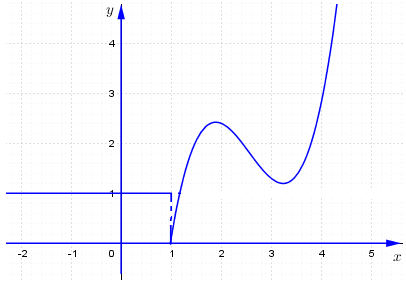Giới hạn \(\mathop {\lim }\limits_{x \to 0} \dfrac{{\sin x - \sin 3x}}{x}\) bằng :
- A.
\( - 1\)
- B.
\(\dfrac{2}{3}\)
- C.
\( - 2\)
- D.
\(0\)
Bước 1: Sử dụng định lý giới hạn
\(\mathop {\lim }\limits_{x \to {x_0}} \left[ {f\left( x \right) + g\left( x \right)} \right] = L + M\) nếu \(\mathop {\lim }\limits_{x \to {x_0}} f\left( x \right) = L;\mathop {\lim }\limits_{x \to {x_0}} g\left( x \right) = M\).
Bước 2: Sử dụng giới hạn \(\mathop {\lim }\limits_{x \to 0} \dfrac{{\sin x}}{x} = 1\).
Với a là một hằng số khác 0 ta có: \(\mathop {\lim }\limits_{x \to 0} \dfrac{{\sin ax}}{x} = \mathop {\lim }\limits_{x \to 0} \dfrac{{a.\sin ax}}{{ax}}\)\( = a.\mathop {\lim }\limits_{x \to 0} \dfrac{{\sin ax}}{{ax}}\)
Bước 1:
Ta có: \(\mathop {\lim }\limits_{x \to 0} \dfrac{{\sin x - \sin 3x}}{x} = \mathop {\lim }\limits_{x \to 0} \dfrac{{\sin x}}{x} - \mathop {\lim }\limits_{x \to 0} \dfrac{{\sin 3x}}{x}\)
Bước 2:
\( = \mathop {\lim }\limits_{x \to 0} \dfrac{{\sin x}}{x} - \mathop {\lim }\limits_{x \to 0} \dfrac{{3.\sin 3x}}{{3x}} = 1 - 3 = - 2\).
Đáp án : C

Các bài tập cùng chuyên đề
Cho hàm số \(f\left( x \right) = \sqrt {x + 1} \). Tính đạo hàm của hàm số tại điểm \({x_0} = 1\)
Khi tính đạo hàm của hàm số \(f\left( x \right) = {x^2} + 5x - 3\) tại điểm \({x_0} = 2\), một học sinh đã tính theo các bước sau:
Bước 1: \(f\left( x \right) - f\left( 2 \right) = f\left( x \right) - 11\)
Bước 2: \(\dfrac{{f\left( x \right) - f\left( 2 \right)}}{{x - 2}} = \dfrac{{{x^2} + 5x - 3 - 11}}{{x - 2}} = \dfrac{{\left( {x - 2} \right)\left( {x + 7} \right)}}{{x - 2}} = x + 7\)
Bước 3: \(\mathop {\lim }\limits_{x \to 2} \dfrac{{f\left( x \right) - f\left( 2 \right)}}{{x - 2}} = \mathop {\lim }\limits_{x \to 2} \left( {x + 7} \right) = 9 \Rightarrow f'\left( 2 \right) = 9\)
Tính toán trên nếu sai thì sai ở bước nào?
Cho hàm số \(f\left( x \right) = \left\{ \begin{array}{l}3 - \sqrt {4 - x} \,\,\,khi\,\,x \ne 0\\1\,\,\,\,\,\,\,\,\,\,\,\,\,\,\,\,\,\,\,\,\,\,\,khi\,\,x = 0\end{array} \right.\) . Khi đó \(f'\left( 0 \right)\) là kết quả nào sau đây?
Cho hàm số \(f\left( x \right) = \left\{ \begin{array}{l}\sqrt x \,\,\,khi\,\,x > 1\\{x^2}\,\,\,\,\,khi\,\,x \le 1\end{array} \right.\). Tính \(f'\left( 1 \right)\) ?
Tính tỷ số \(\dfrac{{\Delta y}}{{\Delta x}}\) của hàm số \(y = 2{x^3}\) theo \(x\) và \(\Delta x.\)
Cho hàm số \(f\left( x \right) = \left\{ \begin{array}{l}2x + 3\,\,\,\,\,\,\,\,\,\,\,\,\,\,\,\,\,\,\,\,\,\,\,\,\,khi\,\,x \ge 1\\\dfrac{{{x^3} + 2{x^2} - 7x + 4}}{{x - 1}}\,\,khi\,\,x < 1\end{array} \right.\). Giá trị của \(f'\left( 1 \right)\) bằng:
Cho hàm số \(y = f\left( x \right)\) xác định: \(f\left( x \right) = \left\{ \begin{array}{l}\dfrac{{\sqrt {{x^2} + 1} - 1}}{x}\,\,khi\,\,x \ne 0\\0\,\,\,\,\,\,\,\,\,\,\,\,\,\,\,\,\,\,\,\,\,\,\,khi\,\,x = 0\end{array} \right.\). Giá trị của \(f'\left( 0 \right)\) bằng:
Xét hai mệnh đề:
(I) $f(x)$ có đạo hàm tại $x_0$ thì $f(x)$ liên tục tại $x_0$.
(II) $f(x)$ liên tục tại $x_0$ thì $f(x)$ có đạo hàm tại $x_0$.
Mệnh đề nào đúng?
Xét hai hàm số: \(\left( I \right):f\left( x \right) = \left| x \right|x,\,\,\left( {II} \right):g\left( x \right) = \sqrt x \) . Hàm số có đạo hàm tại $x = 0$ là:
Cho hàm số \(f\left( x \right) = \left\{ \begin{array}{l}\dfrac{{\sqrt[3]{{4{x^2} + 8}} - \sqrt {8{x^2} + 4} }}{x}\,\,\,khi\,x \ne 0\\0\,\,\,\,\,\,\,\,\,\,\,\,\,\,\,\,\,\,\,\,\,\,\,\,\,\,\,\,\,\,\,\,\,\,\,\,\,\,\,\,\,\,\,\,khi\,x = 0\end{array} \right.\). Giá trị của \(f'\left( 0 \right)\) bằng:
Cho đồ thị hàm số \(y = f\left( x \right)\) như hình vẽ. Mệnh đề nào sau đây sai?

Cho hàm số \(f\left( x \right) = \left\{ \begin{array}{l}\dfrac{{{x^3} - 4{x^2} + 3x}}{{{x^2} - 3x + 2}}\,\,\,khi\,\,x \ne 1\\0\,\,\,\,\,\,\,\,\,\,\,\,\,\,\,\,\,\,\,\,\,\,\,\,\,\,\,\,\,khi\,\,x = 1\end{array} \right.\). Giá trị của \(f'\left( 1 \right)\) bằng:
Cho hàm số \(f\left( x \right) = \dfrac{{{x^2} + \left| {x + 1} \right|}}{x}\). Tính đạo hàm của hàm số tại \({x_0} = - 1\).
Xét hai câu sau:
(1) Hàm số \(y = \dfrac{{\left| x \right|}}{{x + 1}}\) liên tục tại $x = 0.$
(2) Hàm số \(y = \dfrac{{\left| x \right|}}{{x + 1}}\) có đạo hàm tại $x = 0.$
Trong 2 câu trên:
Tìm $a$ để hàm số \(f\left( x \right) = \left\{ \begin{array}{l}\dfrac{{{x^2} - 1}}{{x - 1}}\,\,khi\,\,x \ne 1\\a\,\,\,\,\,\,\,\,\,\,\,\,\,khi\,\,x = 1\end{array} \right.\) có đạo hàm tại $x = 1.$
Tìm $a, b$ để hàm số \(f\left( x \right) = \left\{ \begin{array}{l}\dfrac{{{x^2} + 1}}{{x + 1}}\,\,khi\,\,x \ge 0\\ax + b\,\,khi\,\,x < 0\end{array} \right.\) có đạo hàm tại điểm $x = 0.$
Cho hàm số \(f\left( x \right) = \left\{ \begin{array}{l}a{x^2} + bx\,\,khi\,\,x \ge 1\\2x - 1\,\,\,\,\,\,\,khi\,\,x < 1\end{array} \right.\). Tìm $a, b$ để hàm số có đạo hàm tại $x = 1.$
Với hàm số \(f\left( x \right) = \left\{ \begin{array}{l}x\sin \dfrac{\pi }{x}\,\,khi\,\,x \ne 0\\0\,\,\,\,\,\,\,\,\,\,\,\,\,\,khi\,\,x = 0\end{array} \right.\) . Để tìm đạo hàm \(f'\left( 0 \right)\) một học sinh lập luận qua các bước sau:
Bước 1: \(\left| {f\left( x \right)} \right| = \left| x \right|\left| {\sin \dfrac{\pi }{x}} \right| \le \left| x \right|\)
Bước 2: Khi \(x \to 0\) thì \(\left| x \right| \to 0\) nên \(\left| {f\left( x \right)} \right| \to 0 \Rightarrow f\left( x \right) \to 0\)
Bước 3: Do \(\mathop {\lim }\limits_{x \to {0^ + }} f\left( x \right) = \mathop {\lim }\limits_{x \to {0^ - }} f\left( x \right) = f\left( 0 \right) = 0\) nên hàm số liên tục tại $x = 0.$
Bước 4: Từ $f(x)$ liên tục tại \(x = 0 \Rightarrow f\left( x \right)\) có đạo hàm tại $x = 0.$
Lập luận trên nếu sai thì bắt đầu từ bước nào?
Cho hàm số \(f\left( x \right) = x\left( {x - 1} \right)\left( {x - 2} \right)...\left( {x - 1000} \right)\). Tính \(f'\left( 0 \right)\) ?
Tìm $a, b$ để hàm số \(f\left( x \right) = \left\{ \begin{array}{l}a{x^2} + bx + 1\,\,\,\,\,\,\,\,\,\,\,khi\,\,x \ge 0\\a\sin x + b\cos x\,\,\,\,khi\,\,x < 0\end{array} \right.\) có đạo hàm tại điểm \({x_0} = 0\).












